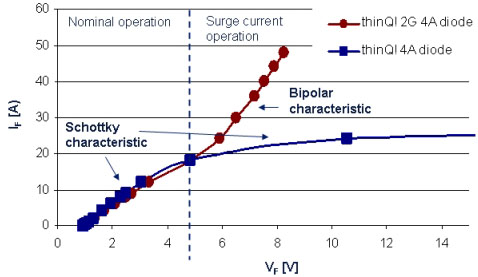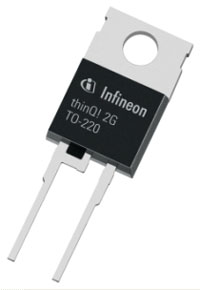The power factor correction (PFC) market is primarily affected by global regulations related to reducing harmonic distortion. Europe's EN61000-3-2 is one of the basic regulations for the AC and DC power supply market, and similar standards exist in the UK, Japan and China. EN61000-3-2 specifies harmonic standards for all off-line devices that consume more than 75W. Since North America does not have regulations governing PFC, energy savings and space/cost considerations are additional drivers of the need to use PFC in consumer products, computers, and communications.
This article refers to the address: http://
Active PFC has two general modes: discontinuous current mode (DCM) and continuous current mode (CCM) using triangular and trapezoidal current waveforms. DCM mode is generally used for applications with output power between 75W and 300W; CCM mode is used for applications with output power greater than 300W. When the output power exceeds 250 W, the PFC is cost-effective because other aspects (such as efficiency) are compensated for, so there is virtually no additional cost.
Active PFC is a server system architecture (SSI) conformance requirement: the power supply module should use a universal power input with active power factor correction to reduce harmonics and comply with EN61000-3-2 and JEIDA MITI standards. This requires high power density applications to provide a wide input voltage range (85~265V), which places special demands on the semiconductors used in PFC stage circuits.
When inputting 85V AC voltage, there must be a minimum Rdson because the conduction heat loss is inversely proportional to the 3rd power of the input voltage. The high frequency operation of this MOSFET can significantly reduce boost rejection. Therefore, the fast switching characteristics of the transistor are necessary. The boost diode should have fast switching, low Vf and low Qrr characteristics. In order to reduce the peak current pressure of the MOSFET when it is turned on, a low Qrr is necessary. Without this feature, the boost MOSFET will increase the temperature and Rdson, resulting in more power loss, which reduces efficiency. Efficiency in high power density applications is a key factor in achieving smaller volumes (30 W/cm3 inches) and reducing passive device size. Therefore, a high switching frequency is essential.
In order to design the CCM PFC with optimum efficiency and form factor, the boost diode must also have the following characteristics: short reverse recovery and forward recovery time; minimum stored charge Q; low leakage current and lowest switching loss. Overvoltage and surge current capabilities are important to handle surges and overcurrents in the PFC caused by startup and AC fallback. These characteristics can only be achieved with a silicon carbide Schottky diode (SiC Schottky diode).
Due to the lack of forward and reverse recovery charges in SiC Schottky diodes, smaller boost MOSFETs can be used. In addition to the reduced cost, the device temperature is also reduced, which makes the SMPS more reliable.
Since the switching behavior of SiC Schottky diodes is independent of forward current (Iload), switching speed (di/dt), and temperature, this diode is easy to use in design. SiC Schottky diodes are used in the design to achieve maximum switching operating frequencies (up to 1MHz), allowing the use of smaller passive components.
The lowest switching loss and low Vf can use smaller heat sinks or fans. In addition, due to the positive temperature coefficient, SiC Schottky diodes can be placed in parallel very conveniently.
thinQ!2G moves toward the ideal high voltage diode
The new generation of IFX SiC Schottky diodes (thinQ! 2G) combines a common SiC Schottky diode with a bipolar pn structure for very high inrush current withstand and stable overvoltage characteristics.
Figure 1 compares the SiC Schottky diode structure with the combined pn Schottky diode concept. The p-region is optimized for emitter efficiency and conductivity, so it can be used as a bypass path for inrush currents when the forward voltage exceeds 4V.

Figure 1: (a) a cross-sectional view of a conventional SiC Schottky diode; (b) a thinQ! 2G SiC diode with a p-doped island
Improved surge current capability
thinQ!2G provides an improved inrush current capability that allows for the design of average current conditions in the application, which means that most surges and overcurrents caused by startup and AC fallback are well handled. Figure 2 shows that in normal operation, thinQ!2G behaves in the same way as a normal Schottky diode with zero reverse recovery charge. In the high current state, its forward characteristics are like bipolar pn diodes, which can significantly reduce power loss. .

Figure 2: Comparison of inrush currents between SiC Schottky diodes and thinQ!2G
Due to the improved inrush current capability, it is possible to design a diode with a lower nominal current in a given application. So far, the surge current rating of the diode is still an important design consideration. The thinQ of the 6A diode IFSM=21A@10ms, which already has a good inrush current rating, is greatly enhanced to the thinQ!2G of IFSM 49A@10ms.
Tests on practical applications (6A IFX first generation SiC Schottky diodes, PFC, wide range) confirm these improvements: 6A first generation SiC Schottky diodes are sufficient to handle inrush current during startup, junction temperature Will rise to 50 ° C. This situation is very close to thermal runaway due to Schottky characteristics, as shown in Figure 2. A smaller volume of diode can be used under normal conditions.
The new 4A thinQ!2G is better able to handle boot conditions in the same application. The temperature is only raised to 35 °C. Due to the bipolar nature, no heat runaway occurs when the maximum junction temperature is reached. Designed to work under normal conditions, thinQ!2G has enough margin to handle anomalies.
Stable overvoltage characteristics
In addition to the improved inrush current capability, the thinQ!2G incorporating the pn Schottky concept can withstand the actual avalanche current breakdown conditions. This is not possible with any other SiC Schottky diode currently on the market. This is due to the low resistivity and design of the p-island in the combined Schottky structure, which ensures that the avalanche begins before the electric field at the Schottky interface reaches the destructive value (Figure 3).

Figure 3: stable overvoltage characteristics of thinQ!2G
The positive temperature coefficient makes the thinQ!2G have stable avalanche and overvoltage behavior, and enables PFC-level applications in telecom and service networks connected directly to the power grid with higher reliability and immunity during transient pulse and overvoltage conditions. Sex and robustness.
During transient changes in the PFC stage, the overvoltage can be Zener breakdown by a large capacitor (for a commonly used 450V bulk capacitor) of about 500~550V. Under this stress condition, thinQ!2G is able to move away from dangerous overvoltage behavior. This improved overvoltage and surge current capability reduces the diode's pressure and makes the application more reliable.
SiC Schottky Diodes - Solutions for a wide range of power supply conditions
Utilizing silicon carbide with unique properties as a device material, it can produce boost diodes close to ideal functional characteristics and is suitable for various power levels in PFC applications. SiC Schottky diodes have no reverse recovery charge, and the reverse characteristics are independent of switching speed, temperature, and forward current to reduce power loss in PFC applications. This is especially important for servers and high-end PC power supplies, as efficiency requirements become more important, especially when meeting regulatory requirements such as 80plus.

Figure 4: Infineon's thinQ! 2G silicon carbide Schottky diode
thinQ!2G adds unique overcurrent and overvoltage capabilities to these important properties. The inrush current capability helps to design the rated current value during steady-state operation, and has a cost advantage due to the lower rated current value of the diode. Overvoltage characteristics are important in demanding environments such as telecommunications and wireless infrastructure applications. In these applications, robust capabilities that overcome overvoltage spikes and abnormal line conditions and thereby improve reliability are necessary.
Increasing efficiency by using SiC diodes that provide the lowest switching losses is often used in systems such as UPS and solar inverters, where each loss reduction directly leads to good returns. For increasing efficiency goals, we hope that the application of silicon carbide diodes can shift to lower power levels: using thinQ! 2G can meet more applications that require higher ambient temperatures, higher device temperatures and higher reliability.
Washing machines are very common in every family. Banshen washing machines, with high quality, good design and best service. Many products have been sold to over 30 countries. After many years of developing, banshen washing machines are getting better and better.
Our well-equipped facilities and excellent quality control throughout all stages of production enable us to guarantee total customer satisfaction. Besides, we have received CE, CB, RoHS and CCC certifications.
As a result of our high quality products and outstanding customer service, we have gained a global sales network reaching America, Asia, Europe, Africa, the Middle East and other countries and regions.
If you are interested in any of our products or would like to discuss a custom order, please feel free to contact us. We are looking forward to forming successful business relationships with new clients around the world in the near future.
3~3.8kg Twin Tub Washing Machine
Small Washing Machine,Portable Twin Tub Washing Machine,Portable Washing Machine And Dryer,Semi Automatic Twin Tub Washing Machine
Ningbo Banshen Electric Appliance Co., Ltd , https://www.banshendq.com
![<?echo $_SERVER['SERVER_NAME'];?>](/template/twentyseventeen/skin/images/header.jpg)